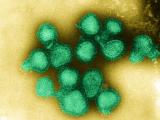(CIDRAP Business Source Osterholm Briefing) – As the novel H1N1 influenza virus (aka the "swine flu") spreads to more countries and sickens more people, the question invariably arises, when will the World Health Organization (WHO) change the pandemic alert level to phase 6?
It's a fair question, though not necessarily the most important one. We often measure the magnitude of events and dilemmas by numbers. The problem is I hear a great deal of confusion about what such a change means.
So let me set the record straight
The WHO phases measure the transmission ability of the virus, not the severity of a pandemic. If your plan hinged on a severe scenario, you may be finding yourself in a tough spot at the moment, trying to explain what all the fuss has been about.
Don't be surprised if the WHO bumps the phase to 6 any day now. In some ways, Margaret Chan, MD, director-general of the WHO, has been foreshadowing just such an announcement. But know that phase 6 is not necessarily a proclamation of disaster.
What about severity?
With the exception of the severe illnesses it caused in Mexico, the new virus is behaving in many ways like a mild seasonal influenza strain. And even the proportion of cases in Mexico that can be considered severe may be very small if we consider the many mild cases that were likely missed with the current disease surveillance conducted by the Mexican public health authorities.
If and when the WHO announces a move to phase 6, the outbreak will be officially dubbed a pandemic. As such, according to the new WHO definitions, the virus will be causing "sustained community level outbreaks in at least one other country in another WHO region." In other words, phase 6 means the virus is causing widespread human infection.
Will it continue to cause mild illness? First, let me say that if you or someone in your care has come down with seasonal influenza any time recently, you may not think "mild" is an adequate word to describe the illness. Any strain of flu will make a person feel horrible, and some people worse than others. Which is exactly why we work so hard to immunize people each year.
As to the question, will the novel virus continue to cause so-called mostly mild illness, the truth is that not a soul on the planet can provide an answer yet. As I've said before, the virus could fizzle out in days, weeks, or months without causing more severe illness than a mild seasonal influenza strain would. Or it could go away for a few months, only to reappear in a form that could cause severe sickness and death. And yet another scenario is the virus continues on its present course, mutating as it passes through the population to become much more dangerous.
Can you cancel 'red alert'?
As I mentioned in my last column, the best response is always a proportional response. Actions need to be tied to the level of risk. Only in this way can we maintain our credibility. And that brings me to the topic of school closures.
Given that the novel virus is behaving like the seasonal influenza, certain community mitigation measures implemented early on out of caution are no longer warranted. For example, the Minnesota Department of Health (MDH) today announced that it would no longer recommend school closures when a student is identified as having the novel H1N1 influenza. That's a prime example of proportional response.
Don't be surprised to see the US Centers for Disease Control and Prevention (CDC) revise its guidelines about school closures, too, if the current pattern of mild illness persists. It makes so much more sense to keep one sick child home (whether the illness is caused by the new virus or a strain of seasonal influenza) than to cause the disruption of entire schools, which can put an unnecessary burden on your employees and your business. And, in the long run, it's an action that should reinforce credibility.
I’d urge your organization to think in terms of proportional response, too. Would you ban travel to places like Mexico if the seasonal influenza virus were causing illness similar to the illness that this new H1N1 influenza strain is causing? I don’t think so. My rule of thumb right now is to ask, "Would I recommend our organization take this action if we were responding to routine seasonal influenza?" If your answer is yes, then that's a proportional response. If not, ask yourself why you are making this recommendation for dealing with the novel H1N1.
What to make of media coverage
The whipsaw of media attention is stunning. Just last week, in search of a new angle to the novel influenza strain, reporters from prestigious media outlets were sleuthing for evidence that government officials had not been forthcoming soon enough about how serious the outbreak was. This week, the prattle has flip-flopped. Now the media suspect that much ado has been made about the outbreak and that that public health officials overreacted.
What is distressing is that as the media industry, particularly the print business, has contracted, some of the finest health reporters in the nation have lost their positions. I have tremendous respect for solid journalism, and I make myself available to reporters as much as possible to help keep the record straight. So I can tell you that without a doubt the quality of questions coming my way indicates a growing ignorance about the field of infectious diseases.
Not only is this discouraging, it's downright dangerous. You cannot count on the media (with notable exceptions) to give you reliable information. So I urge great caution when reading, listening to, or reviewing any story that relates to this novel H1N1 influenza outbreak. I urge you to caution your C-suite about this as well. They need to know that decision-making simply cannot be made based on the popular media.
From what I've seen—and I've been in the thick of this—for one to believe accusations that public health officials are either underplaying or overblowing information about what could be an emerging pandemic is quite frankly ludicrous.
To make matters worse, as one of my colleagues mentioned today, if you consider the growing new milieu of social networking, you could say that narrow-casting of information has created a kind of echo chamber for misinformation.
Rest assured, that will not be the case with news, information, and resources that come from the Center for Infectious Disease Research and Policy (CIDRAP). Everyone makes mistakes from time to time, but at CIDRAP Business Source, we go the extra mile to make sure you are getting intelligence that is authoritative and reliable.
You have my word on that.
And here is today's breaking news:
- The WHO reported 1,085 confirmed cases of influenza A/H1N1 (swine flu) and 26 deaths in 21 countries as of 18:00 p.m. GMT (noon US EST) today, up from 985 cases in 20 countries reported earlier in the day. Mexico has reported 590 confirmed cases and 25 deaths. The WHO's latest total reflects today's updated US numbers from the CDC, which stand at 286 cases and 1 death. [WHO update 14]
- At a WHO media briefing today, Keiji Fukuda, MD, the WHO's assistant director-general for health security, emphasized that the rationale for any future move to pandemic alert phase 6 wouldn't be based on disease severity, but rather on sustained outbreaks in more than one WHO region. On Apr 29 the WHO raised the pandemic alert to its current level, phase 5, which signifies sustained community outbreaks in two or more countries within one WHO region.
- The CDC will begin reporting "probable" cases of flu in addition to confirmed cases to give a better sense of the size of the US epidemic, acting director Dr. Richard Besser said Monday. In addition to the 286 confirmed cases, there are more than 700 probable cases in the United States.
- The CDC will work with international health authorities to monitor the southern hemisphere's flu season, beginning shortly, to see how the novel H1N1 strain behaves in competition with other flu viruses. "That will tell us a lot about whether the virus is changing and what measures we might want to take in the fall," Besser said.
- Tomorrow the WHO will host its second scientific teleconference to address clinical issues surrounding patients who have influenza A/H1N1 (swine flu) infections, the WHO's Fukuda said today at a media briefing. The conference will allow scientists to share information on crucial topics such as disease severity. The topic of the first teleconference, held on Apr 29, was the influenza situation in Mexico.



















